In May 2017, I was living and working in Chiang Mai, Thailand as part of a low-cost living experiment. For only $600 a month I could live comfortably and work on my online course without worrying about how to pay my $2,000+ bills living back in Minneapolis, Minnesota. At the same time, a friend had alerted me to a video production job opportunity with a Buddhist non-profit in Taiwan, and since Taiwan is only a three-hour flight away from Thailand, I decided to fly to Taiwan to investigate this fortuitous turn of events.
The non-profit company is called Hwadzan Pure Land Association; their goal is to bring about a more peaceful society through promoting traditional Chinese culture, namely Buddhism, Confucianism, and Taoism. They do this through teaching, by means of books, video lectures, study camps, and more. All content is for free distribution. As part of the interview process I was to help them make a promotional video for one of their temples, Shuangxi Temple, in English for a foreign audience; I’ll talk about this later.
Ilha Formosa
I flew in to Taiwan Taoyuan International airport one rainy night in the middle of June. Through the rain-covered windows I gazed at the lights of Taipei and the surrounding cities, wondering what this little island had in store for me. Little did I know of the adventures that awaited me on this baodao (treasure island).
In the sixteenth century, Portuguese sailors referred to Taiwan as Ilha Formosa, which means “beautiful island” and to this day Taiwan is still referred to as Formosa. My would-be colleague, Big Bear, and his family picked me up at the airport because I would be staying with them for the night. I don’t recall much of what Big Bear’s father said to me during the ride along Zhongshan highway to their home, but I recall him saying, with regard to traditional Chinese culture, bu yao kongshou huiqu (don’t return empty-handed). I’m not sure how I knew, but I just felt I was about to embark on a very important time in my life.
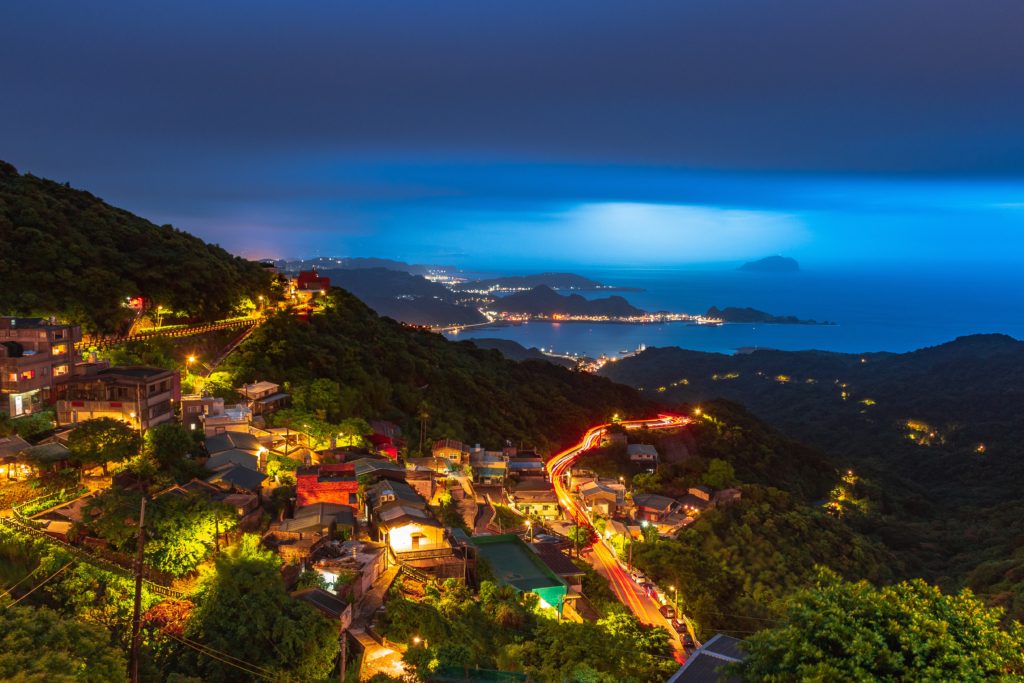
Taiwan
Arriving at Hwadzan Pure Land Association
My first day in Taiwan I visited the Hwadzan office in downtown Taipei. Inside, speakers play Amitabha Buddha name-chanting softly in the background, which is very soothing. Next door to the office is a library with books about traditional Chinese culture, a kitchen, an eating area, a temple, and a residence for the venerables who live there. The word venerable is an honorific term used in the titles of Buddhist monks and nuns.
I learned that Hwadzan is one of many Pure Land Buddhist Societies around the world. Pure Land Buddhism is one of the largest sects of Buddhism, popular in East Asian countries like Japan and China. Hwadzan was founded by Venerable Master Chin Kung, a teacher and monk of the Pure Land tradition, in 1999 in Taipei.
The current director of Hwadzan is Venerable Wu Dao. In addition to being the director of Hwadzan, Venerable Wu Dao is also the president of many Pure Land societies around the world. To my surprise I was introduced to him my first day in Taiwan. He was very kind and gave me a bag full of books about traditional Chinese culture. It included titles like Guidelines for Being a Good Person, To Understand Buddhism, The Art of Living, Changing Destiny, and Heart of a Buddha.
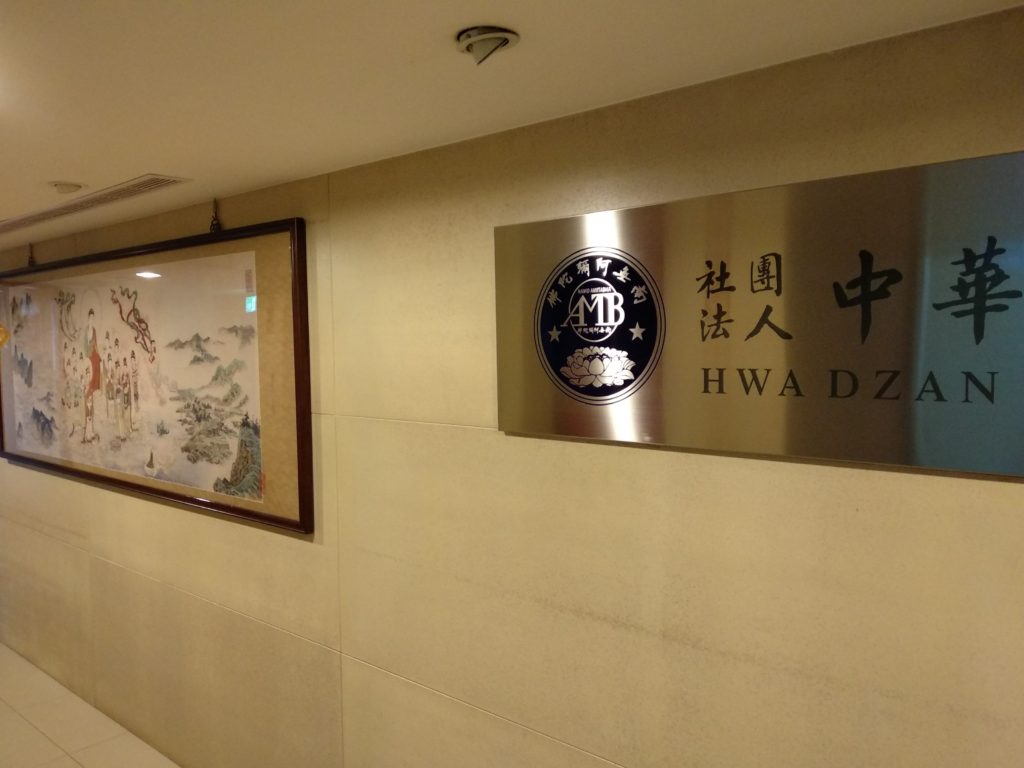
Hwadzan Office
Shuangxi Lingyan Mountain Temple and Retreat Center
Located in the mountainous, rural district of Shuangxi (雙溪, Shwong-she) east of Taipei, Shuangxi Temple sits in a secluded valley several kilometers from the nearest residence. The name Shuangxi refers to two creeks in the district. Shuang (雙) means “twin” or “double” and Xi (溪) means “creek.” The temple is home to many Buddhist monks and nuns; it could also probably be considered a monastery.
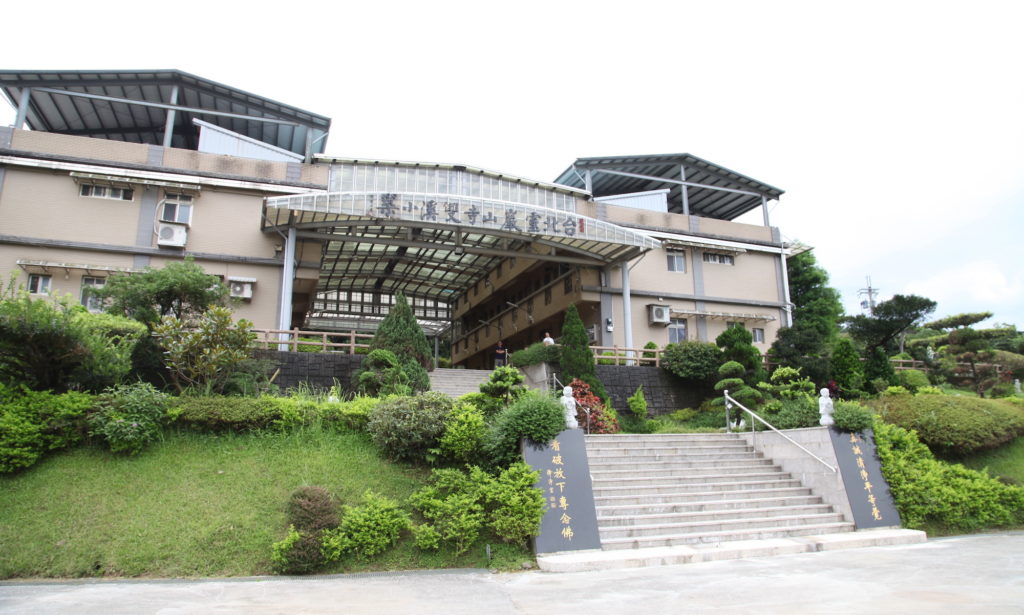 Shuangxi Temple
Shuangxi Temple
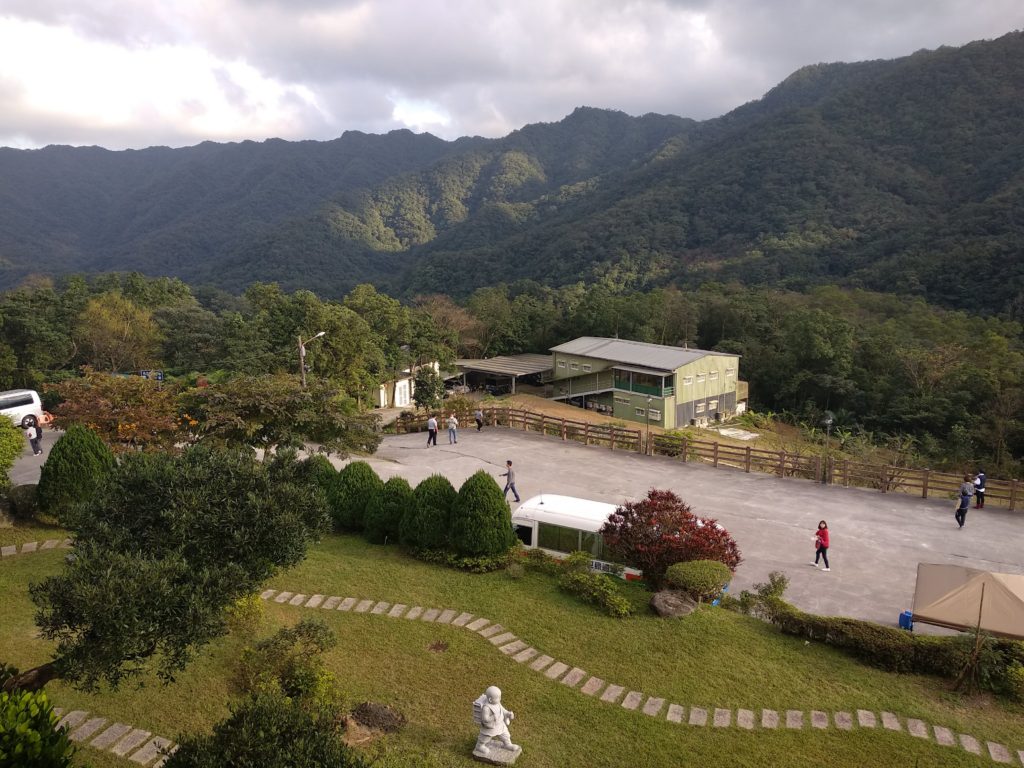
View opposite temple
Temple Origins
Shuangxi Temple was built in 2007 for the Hwadzan Pure Land Association. With a serene, peaceful environment people could practice Buddha name-chanting and at the same time not disturb or be disturbed by others. At the time, there was no road leading to the site of the would-be temple grounds; there was only a dirt path weaving through the mountains and was primarily used by farmers. Before the temple could be built, the volunteers and venerables had to first “open the mountain” (開山) by building a two-kilometer road.
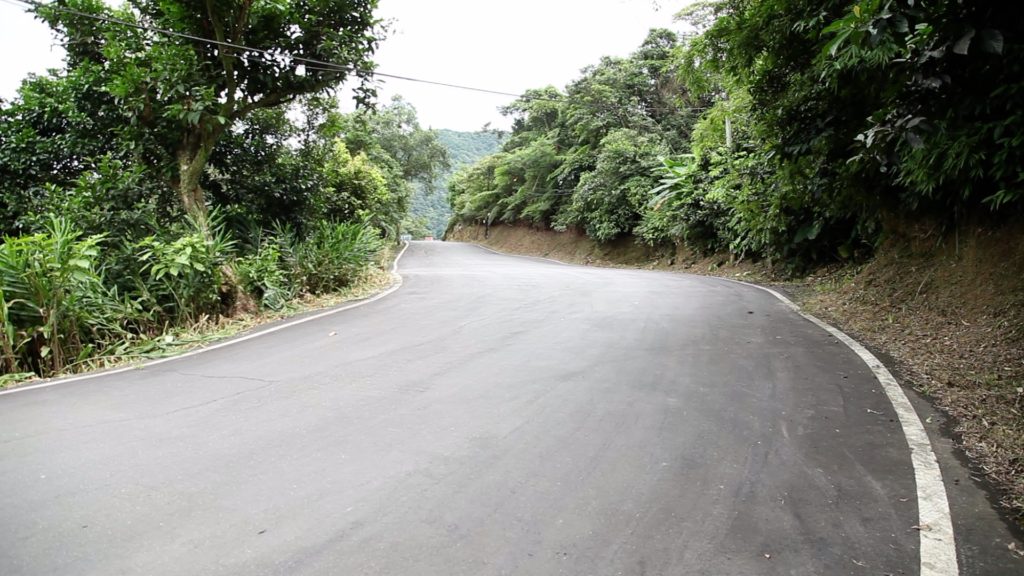 Road to Shuangxi Temple
Road to Shuangxi Temple
Journey to Shuangxi Temple
Everyday at 8:30 am there is a shuttle bus that takes people from Taipei to Shuangxi Temple. After a day or two in Taiwan, it was at the back of one such bus that I found myself riding. With me was fellow video producer, cameraman, and drone operator, Big Bear. As I was new to Taipei and Hwadzan, he was helpful in acting as a guide for me. We had many common interests, including comedy, technology, and a penchant for McDonald’s, which we stopped by frequently for breakfast or second breakfast.
The way to Shuangxi Temple weaves its way through towns, forests, and mountains. There is a Chinese idiom, “a road as twisty as sheep intestines” (羊腸小道), which refers to a narrow and winding road. This is the kind of road that leads deep into the forest valley where the temple lies.
One of the things that struck me most during my trip to the temple was how beautiful the environment was. Shuangxi Temple is the only building in the lush mountain valley. In the distance are many mountain ridges, resembling lotus flower pedals. Quiet and clean, it seemed to me the perfect place to let go of worry and fear and practice mindfulness and contemplation.
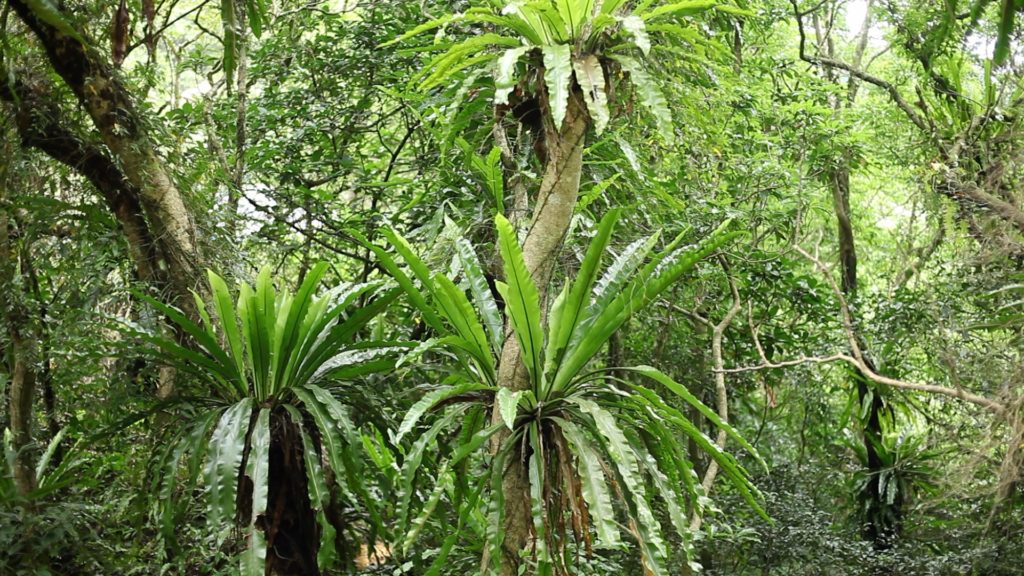
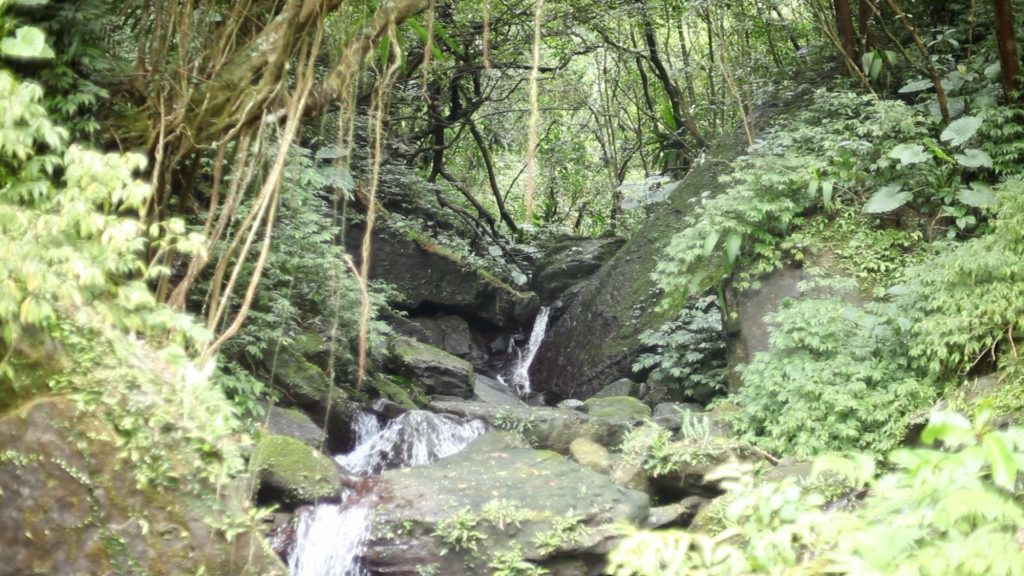
Our plan was to spend a week at the temple to experience life there, learn about traditional Chinese culture, and collect footage for the video I was putting together.
Life on the Mountain
At the temple the day begins at 4:30 with morning classes, followed by breakfast at 6:00. During breakfast it’s common for monks and lay practitioners to eat in silence while watching and listening to videos of Venerable Master Chin Kung preach. All of the meals are vegetarian and all vegetables are grown on the mountain near the temple. After eating, everyone cleans their own dishes and then there are a few hours to rest, explore the area, or sit in contemplation.
In the late morning, the first “hour” of a Thrice Yearning Buddhist Ceremony is held. People come all the way from Taipei to join in the ceremony. The very first ceremony was held at the temple on January 30th, 2010 by Venerable Master Chin Kung, and there has been a ceremony every day since then.
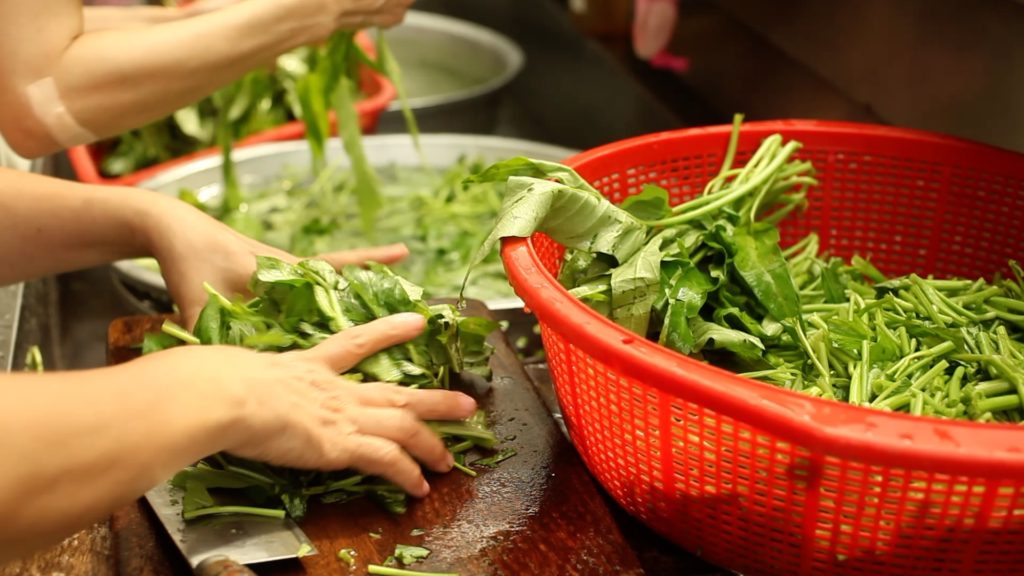
Thrice Yearning Ceremony
The Thrice Yearning Ceremony was established by Venerable Master Zhong Feng during the Yuan dynasty (1271–1368 AD). Thrice refers to the three time of day, morning, midday, and evening, when the ceremonies are held. Its broader meaning is day and night incessantly. Yearning refers to fixing one’s mind on one point. The main purpose of performing the ceremony is to develop our ability to control our thought, protect the world, and alleviate disasters. The prayer service consists of sutra recitation, chanting praises, making vows, Buddha-name recitation, Dharma teachings, and sincere repentance. The entire process is to help us uncover our innate extraordinary ability. There is a Buddhist sutra which says, “If you can concentrate your mind at one point, there is nothing you cannot accomplish.”
The morning ceremony lasts for an hour or so and then everyone has lunch. In the afternoon the second ceremony is held, followed by dinner. In the evening the third and final ceremony is held.
Over the last few years I have had some chances to attend a Thrice Yearning Ceremony. It is a very beautiful experience with everyone chanting Buddha’s name in the night on the mountainside. At Shuangxi there are anywhere from twenty to a few hundred practitioners that join in by my estimations, not including those who join virtually.
After the final ceremony, people either return home via shuttle bus or retire to their dorms to rest. If you would like to stay the night at the temple, make a reservation in advance; contact info is at the end of this post.
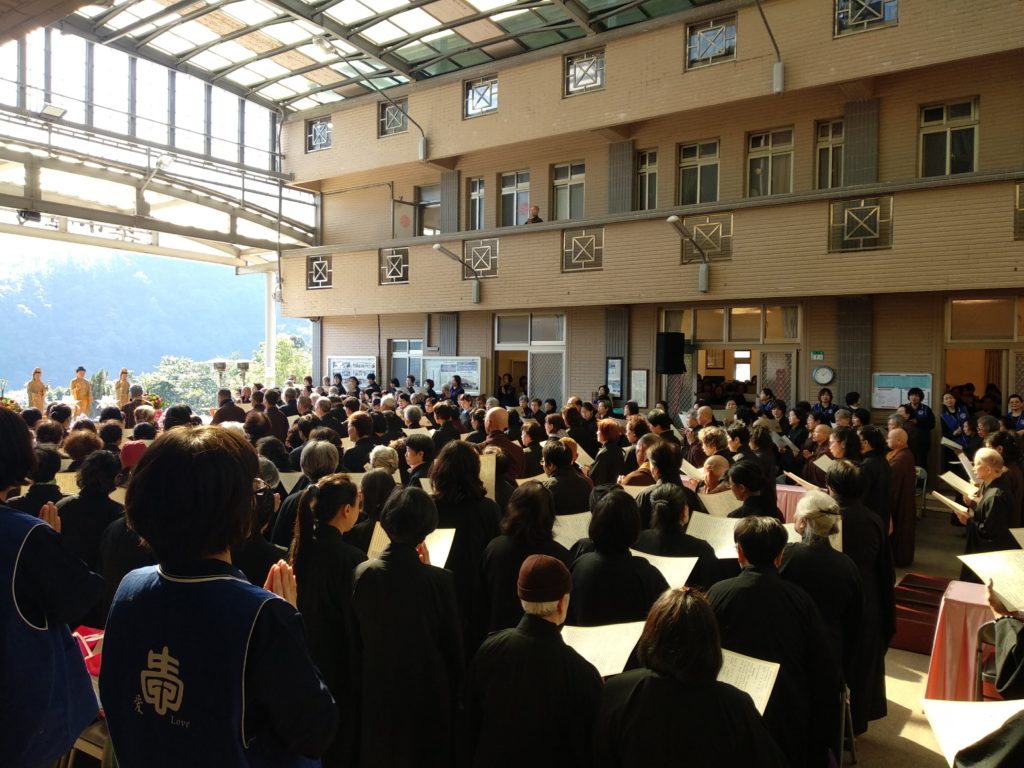 Thrice Yearning Ceremony
Thrice Yearning Ceremony
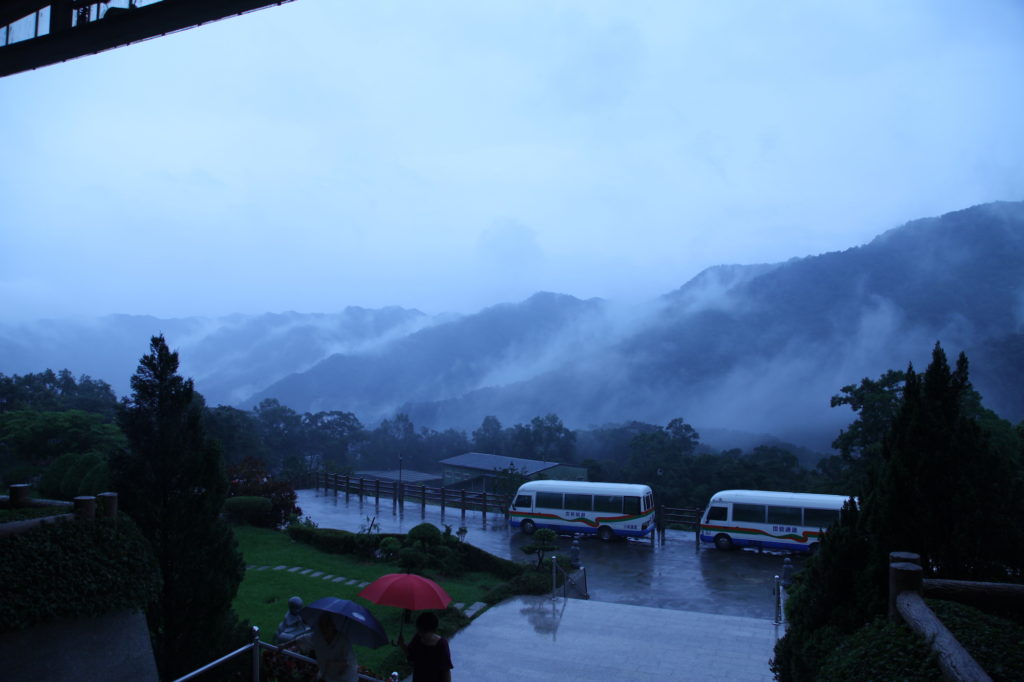
Pure Land Buddhism and Amitabha Buddha
A branch of Mahayana Buddhism, Pure Land Buddhism stresses faith in Amitabha Buddha, meditation on and recitation of his name, and the religious goal of being reborn in his “Pure Land” or “Western Paradise.” All beings have the Buddha nature and anyone can escape the endless realms of reincarnation by attaining Buddhahood. Amitabha is acclaimed by all Buddhas as “The King of All Buddhas.” Because it is difficult to achieve Buddhahood, people recite His name, Amitabha, in order to be reborn in the Western Pure Land where they can quickly attain Buddhahood in one lifetime due to more favorable cultivation conditions. Amitabha is the Buddha of Infinite Light and Infinite Life.
In Buddhism, the word Dharma has three meanings: 1) The teachings of Buddhas; 2) law, doctrine; 3) things, events, phenomena.
What Is Traditional Chinese Culture?
Traditional Chinese culture refers to education, in particular, the teachings of the ancient saints and sages. These saints include Confucius, Lao-Tzu, and the Buddha, and their teachings form Confucianism, Taoism, and Buddhism, respectively, which I’ll discuss below.
Confucianism
During the Han Dynasty (202 BC–220 AD), at the suggestion of one of the emperor’s ministers, Confucianism became the standard of traditional Chinese culture. At the core of Confucianism are the values of filial piety, fraternal love, benevolence, and righteousness. It also emphasizes The Five Cardinal Relationships: love between parent and child (父子有親), distinct responsibilities between husband and wife (夫婦有別), righteousness between superior and subordinate (君臣有義), order between the old and the young (長幼有序), and trust between friends (朋友有信).
Taoism
Taoism emphasizes living in harmony with Tao, meaning “The Way.” The Chinese word Tao/Dao (道) literally means “path,” “way,” or “route.” In ancient times, emperors governed with what is called wuwei (無為) or non-action, a kind of intention-less action in tune with the natural order of the universe, and as a result their world was one of great harmony. There were other phrases I also heard mentioned a lot at the temple, which in my understanding are similar to following The Way; one is “let it be” (順其自然) and the other is “accord with the circumstances” (隨緣).
Buddhism
Buddhism came to China from India during the Han Dynasty about 2,000 years ago; this was a few hundred years after the Warring States period (475–221 BC) when Confucius and Lao-Tzu lived. Buddhism took hold in China and has been an integral part of traditional Chinese culture ever since. Buddhism teaches that the universe and everything in it are created by the mind; as our mind changes so does our environment.
Buddhism teaches what are called the Ten Wholesome Ways which are:
- No Killing (殺生)
- No Stealing (偷盜)
- No Sexual Misconduct (邪淫)
- No lying (妄語)
- No abusive speech (兩舌)
- No slander (惡口)
- No enticing speech (綺語)
- No greed (貪)
- No anger (瞋)
- No ignorance/delusion/attachment (癡)
Basics for Study
Three fundamental books of Confucianism, Taoism, and Buddhism are Guidelines for Being a Good Person (弟子規), Treatise on Response and Retribution (太上感應篇), and Ten Wholesome Ways Sutra (十善業道經), respectively. Because of their love for us, the saints passed on their wisdom to later generations. The British historian Arnold Toynbee has pointed out that in order to solve the problems of the twenty-first century, the teachings of Confucius, Mencius, and Mahayana Buddhism are needed.
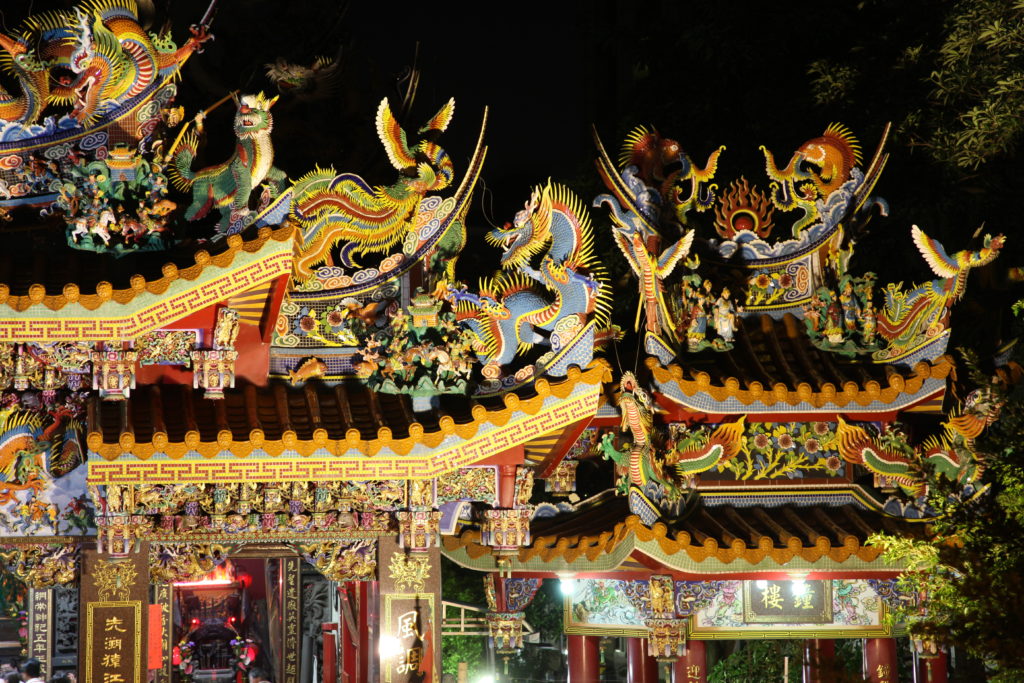 Taoist Temple
Taoist Temple
Collecting Footage and the Surrounding Mountain Towns
One of the things that made the strongest impression on me during this week-long visit to the temple was the kindness and hospitality of the abbot, Venerable Zhuang Xing. He was humorous, hospitable, kind, and energetic. In order to gather footage for the video—and to have fun and explore the area—he took Big Bear and I on several day trips to small mountain towns in the area like Jiufen, Shifen, Shenkeng, and Pingxi.
Shenkeng
The small towns we visited are located along the Keelung River. Furthest to the west is Shenkeng. Shenkeng’s old street is famous for its tofu. One type of tofu served all over Taiwan is stinky tofu. Over the years I have spent living in Asia I have often been proffered stinky tofu and due to its odor, I often decline. This time though, I tried it again. I am not a big fan, but glad that I at least gave it another shot. In addition to trying stinky tofu we went inside a tofu restaurant which retained an old primary school vibe. No detention at this school, we sampled the soybean ice cream and tofu pudding, a snack made with very tender tofu—both were sweet and delicious, perfect on a hot Taiwan summer day.
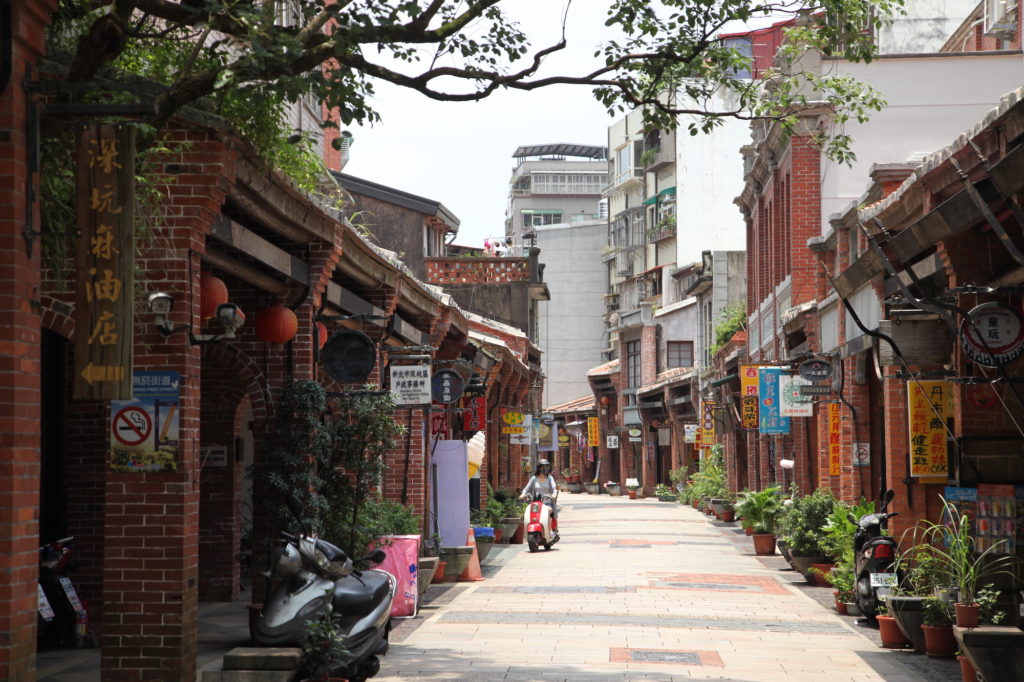
Shenkeng Old Street
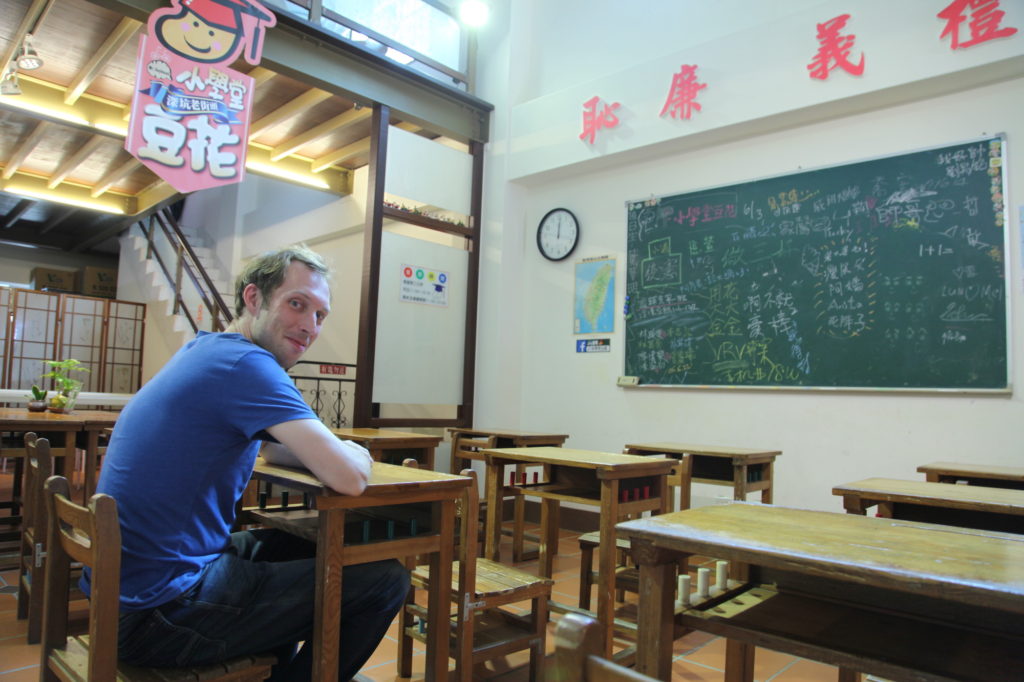
Back to school
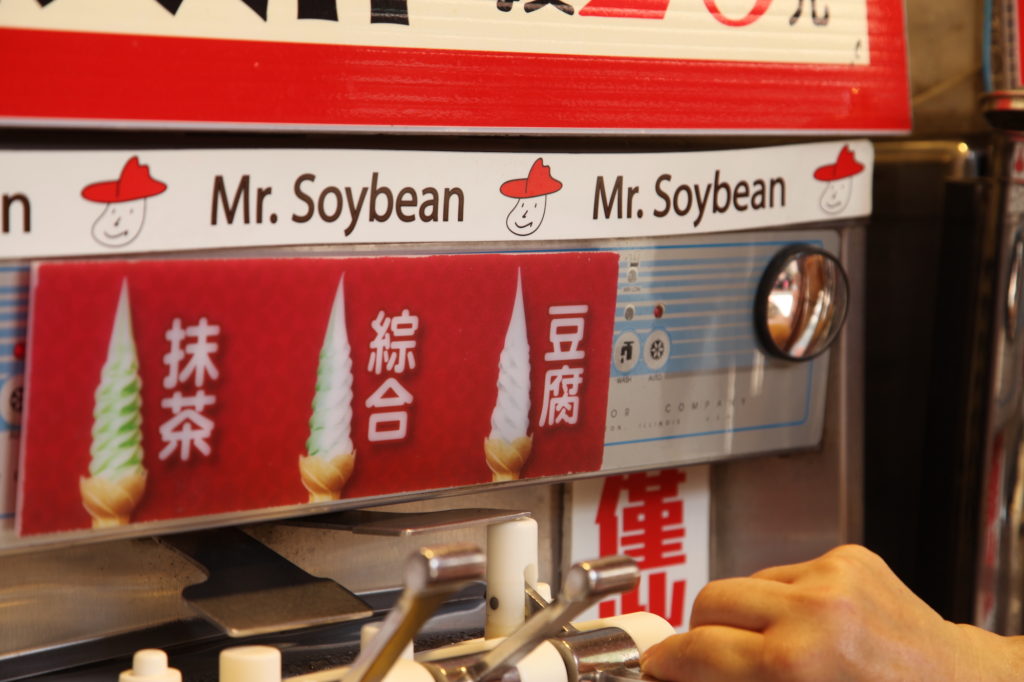
Soybean ice cream
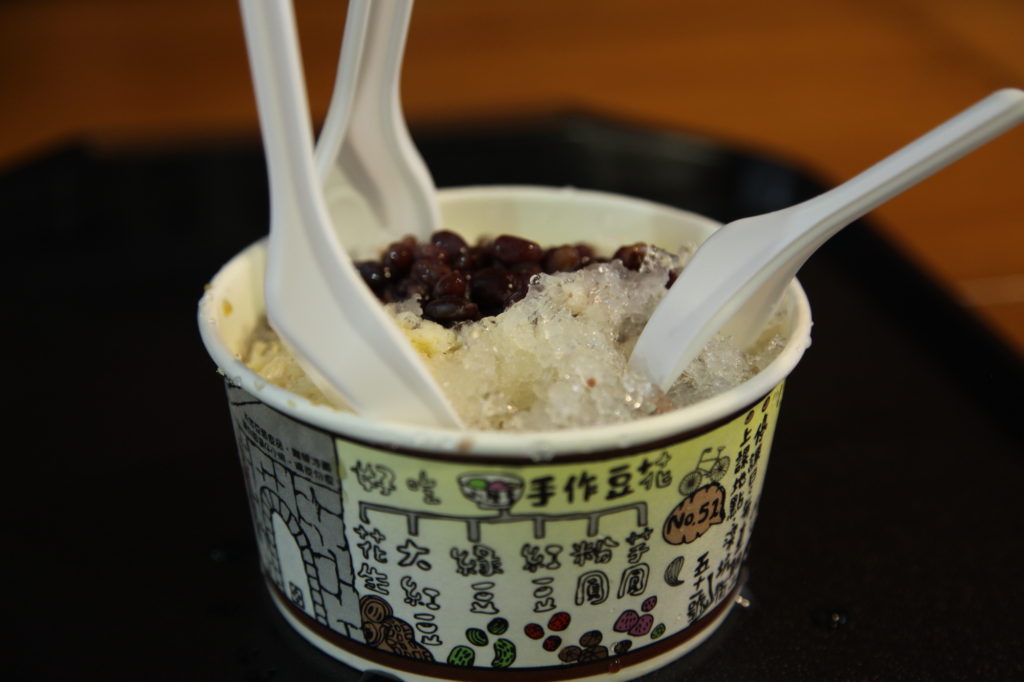
Tofu pudding with ice and sweet red beans
Shiding
Venerable Zhuang Xing was a former cab driver and he seemed to know the mountain roads like the back of his hand. Next up, we explored the mountains and streams around Shiding, collecting footage along the way; we grabbed some drone footage from the top of the mountains and still shots of the flowing streams.
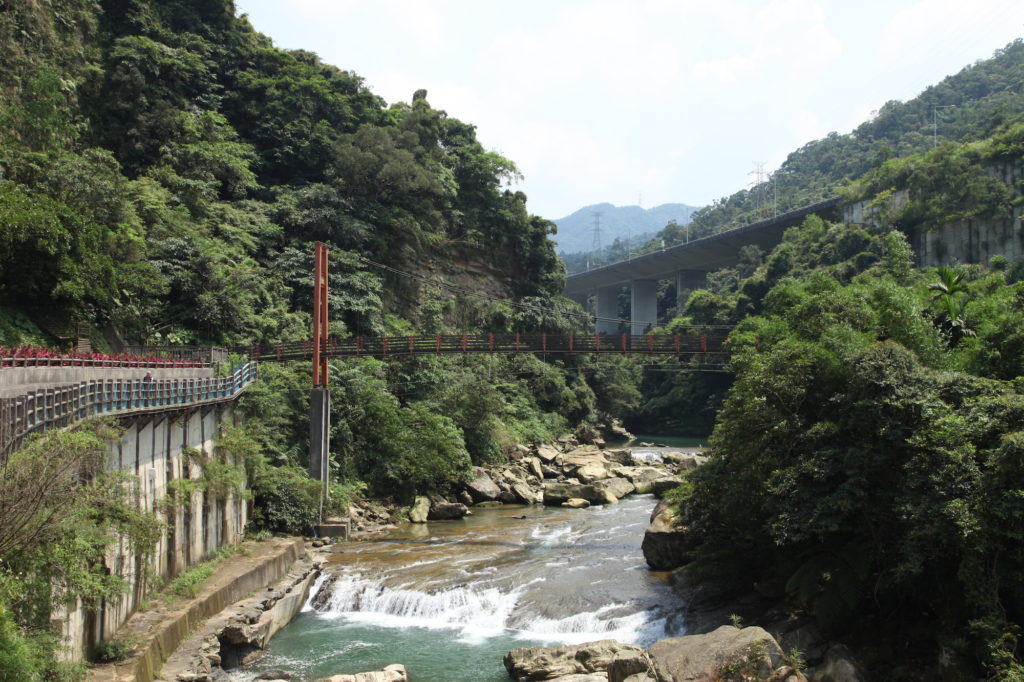
Pingxi
In Pingxi we stopped to have some passion fruit, wax apples, and sugar cane juice. All were quite tasty.
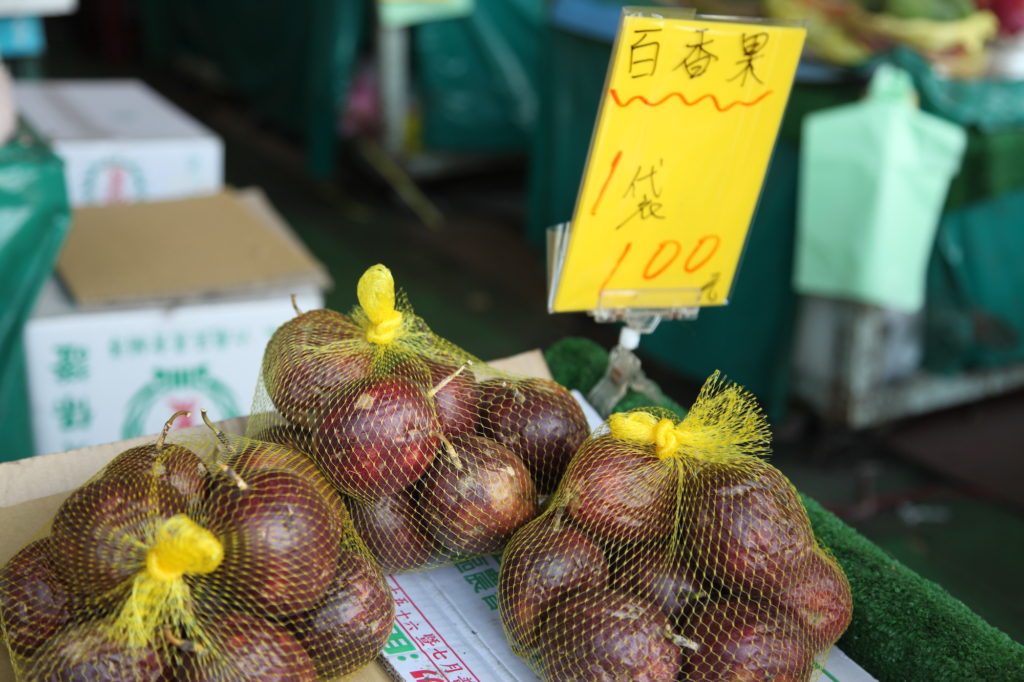
Passion fruit
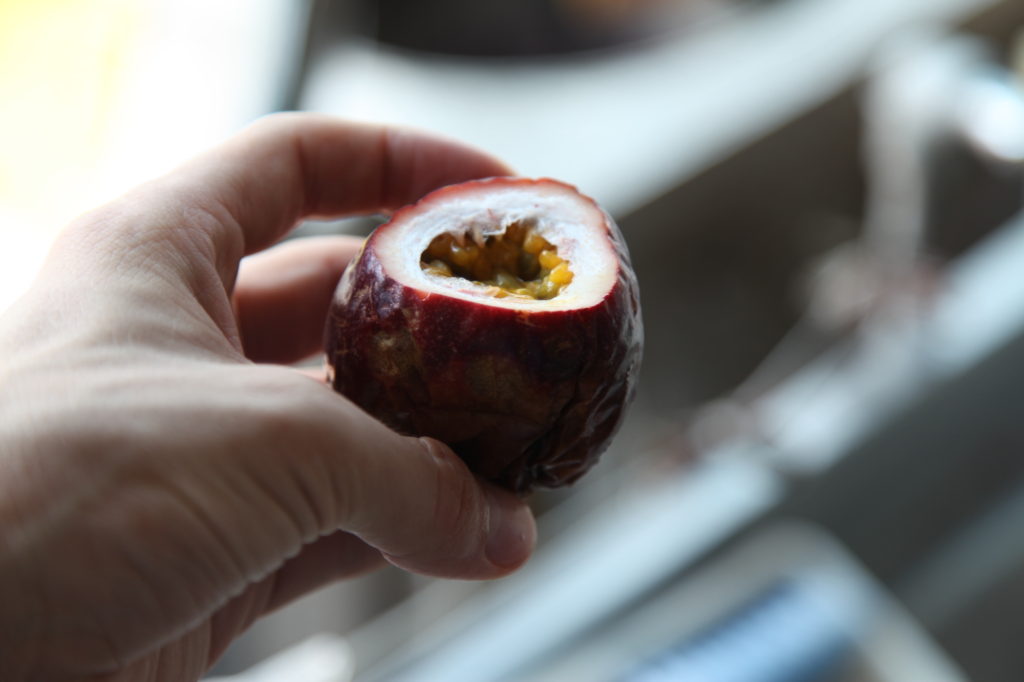
Inside of the passion fruit
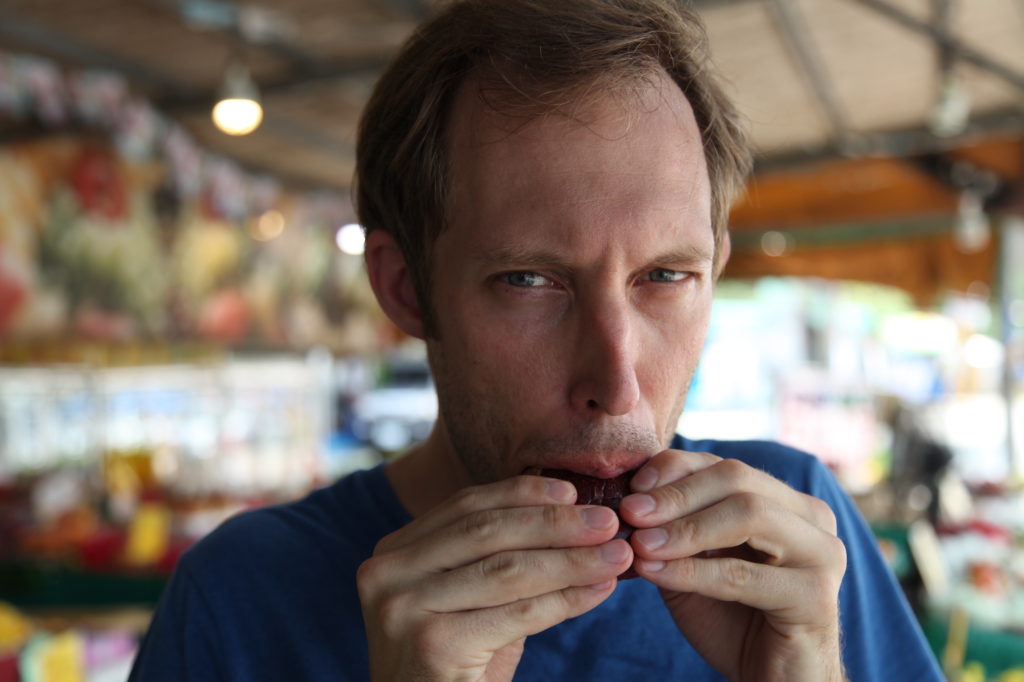
A real passion for passion fruit
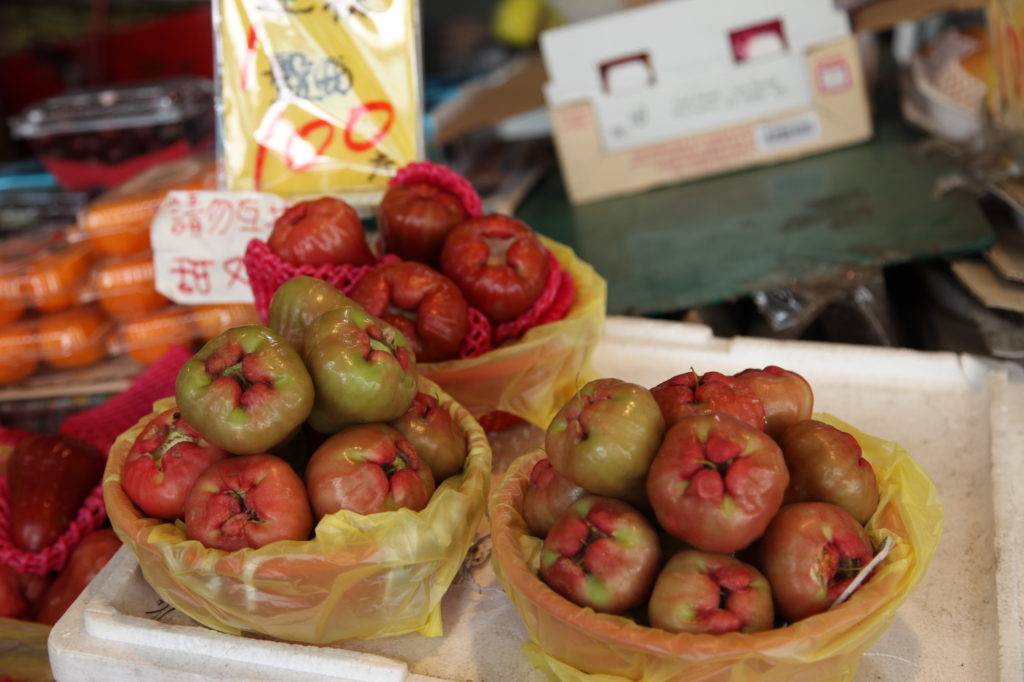
Wax apples, a fruit that tastes similar to a pear and are widely cultivated in the tropics
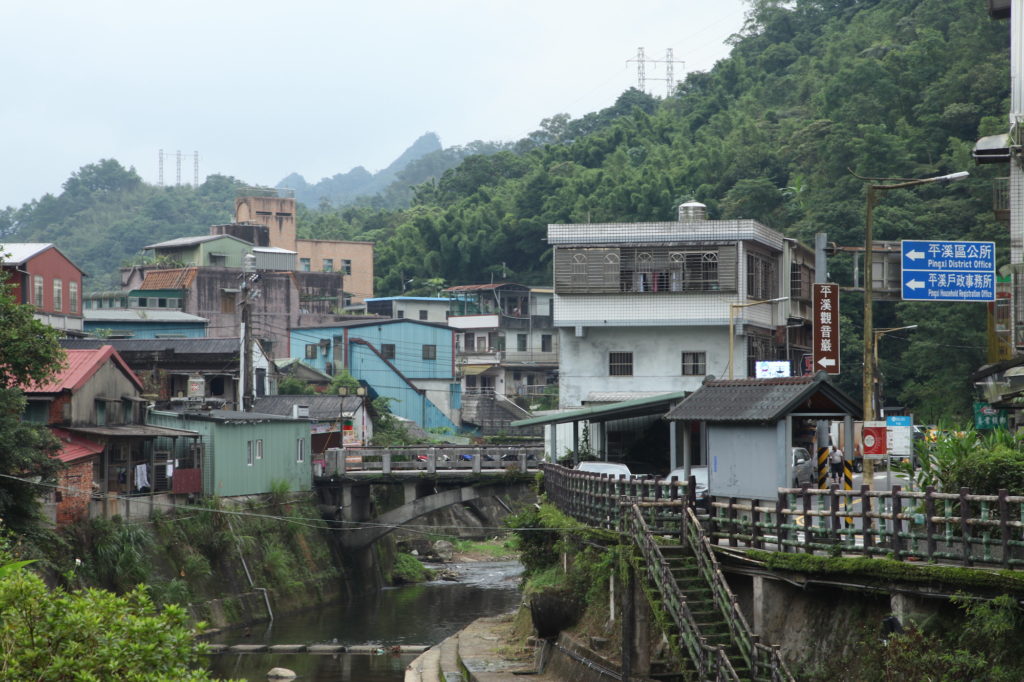
Pingxi town
Shifen
To the northwest of Pingxi lies Shifen. The Shifen train line was originally built to transfer coal but it now a place where visitors come to light sky lanterns. Before releasing them and letting them float away, people write their intentions or wishes on the lantern. Ours said, “We hope that American and China will always get along.” Shifen sure was fun XD!
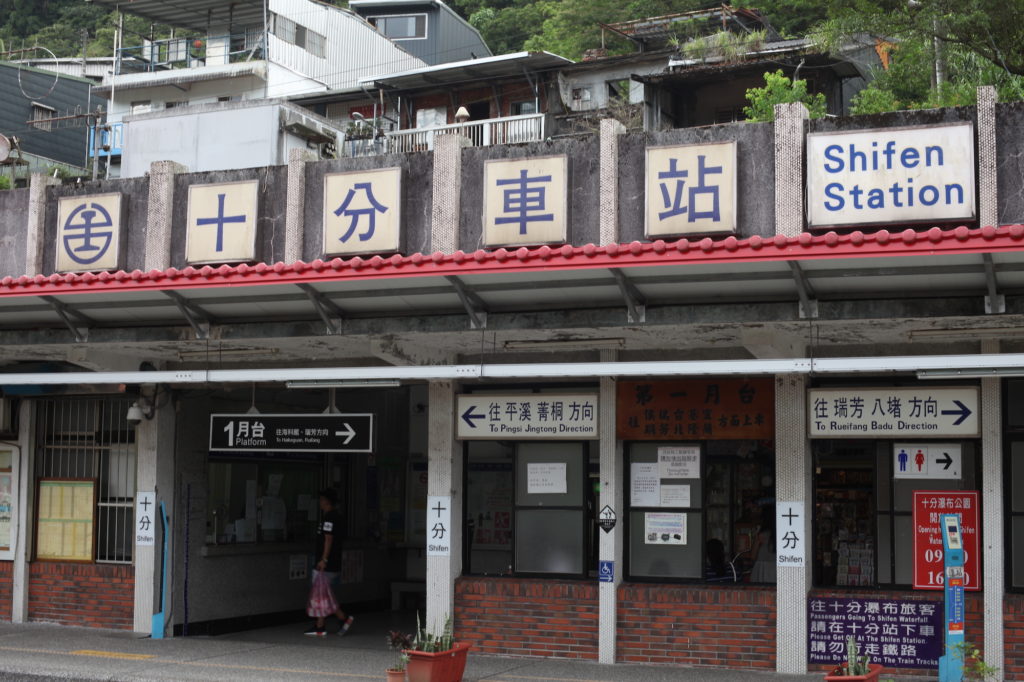
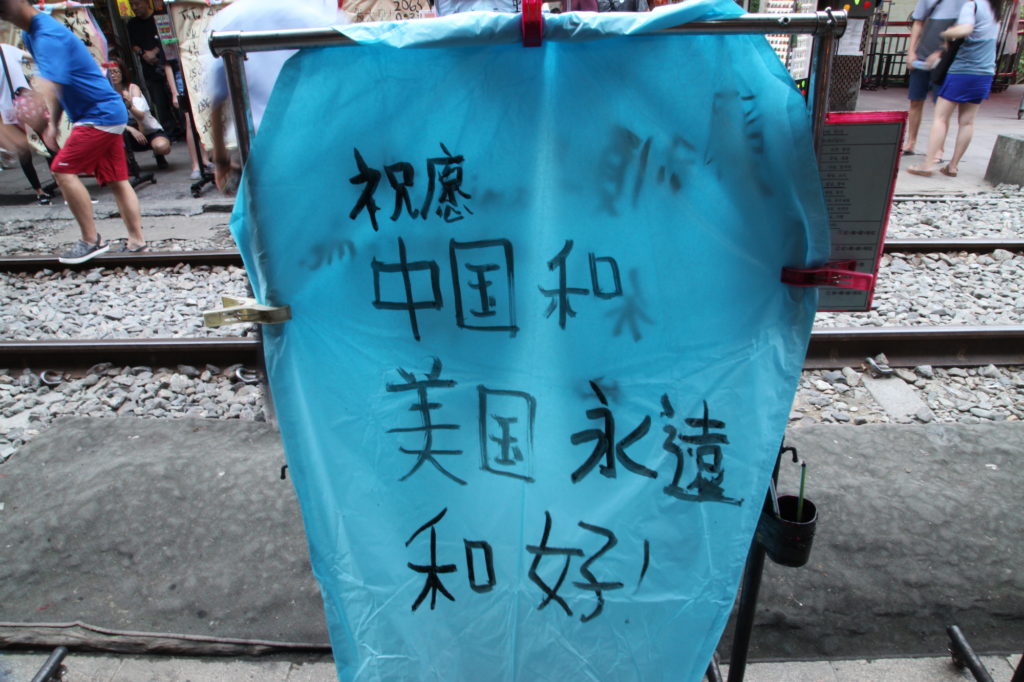
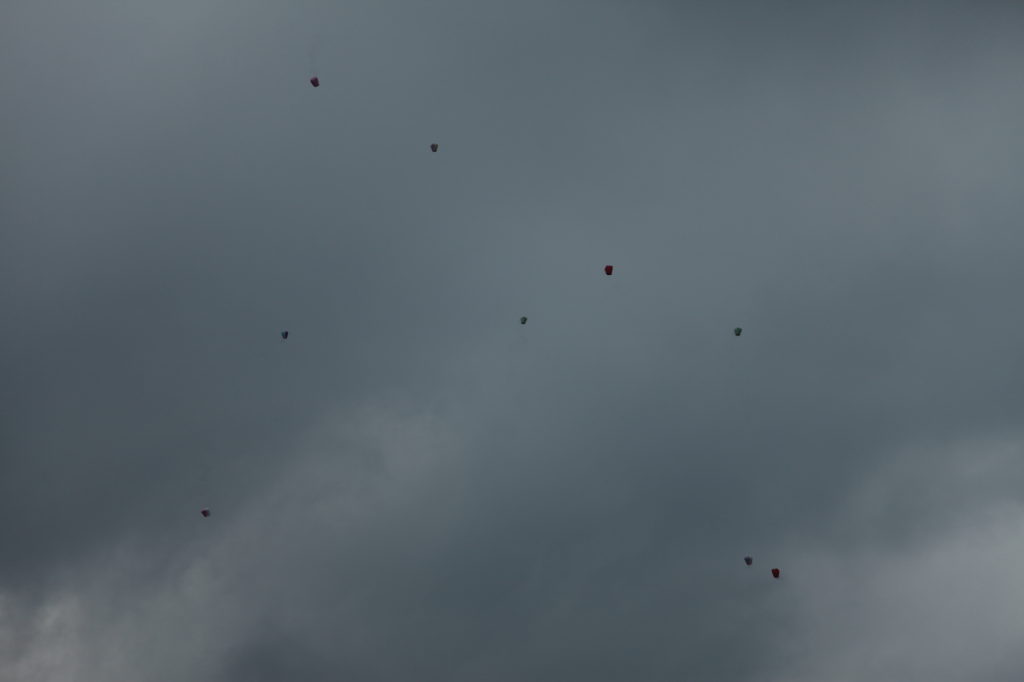
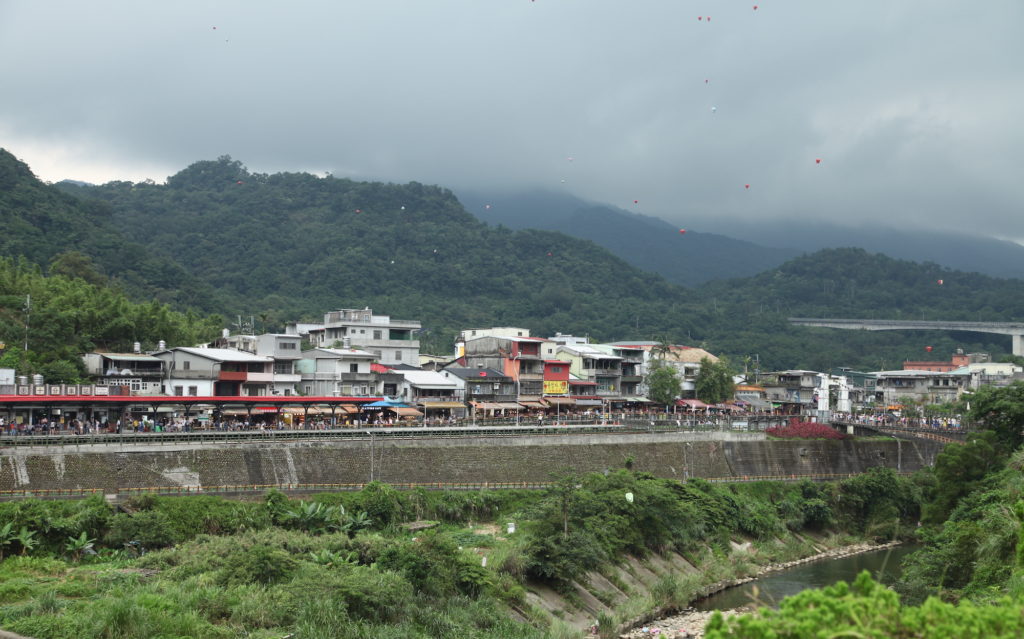
Jiufen
The last town we visited was Jiufen. Jiufen is the most famous of these little mountain towns and has been packed with people every time I have visited. Its old street is long and winding; at points the awnings of the shops block out the sky above. Within it are found many tasty snacks; I recommend the taro balls, soft and sweet. For fan’s of Hayao Miyazaki movies it’s rumored that the tea houses in Jiufen were the inspiration for the bathhouse in Spirited Away, but it’s just a coincidental resemblance.
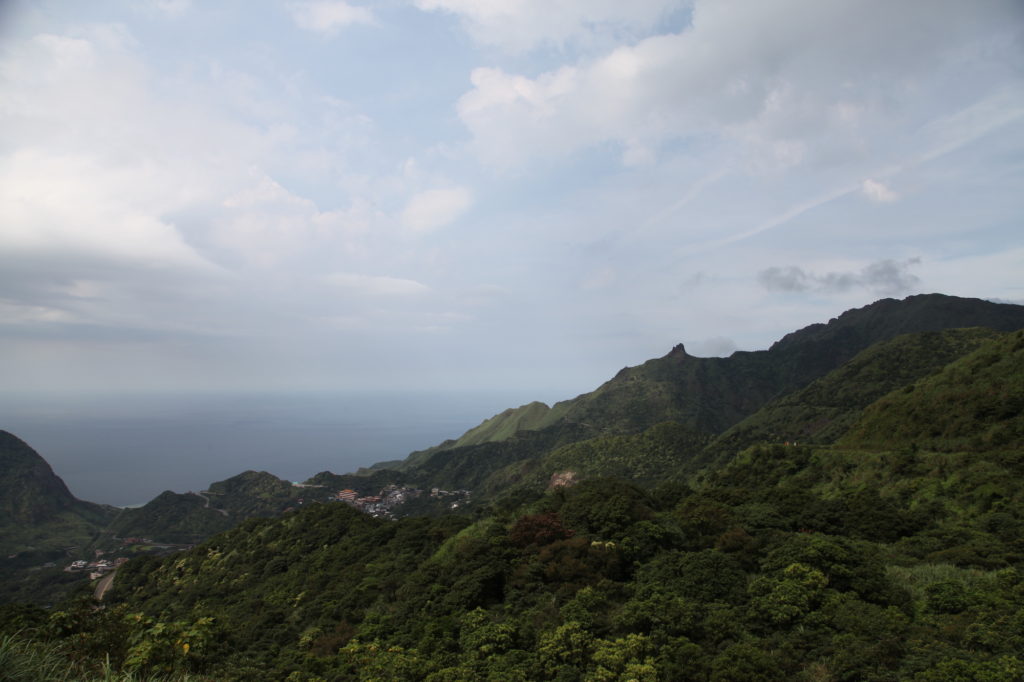
Teapot mountain
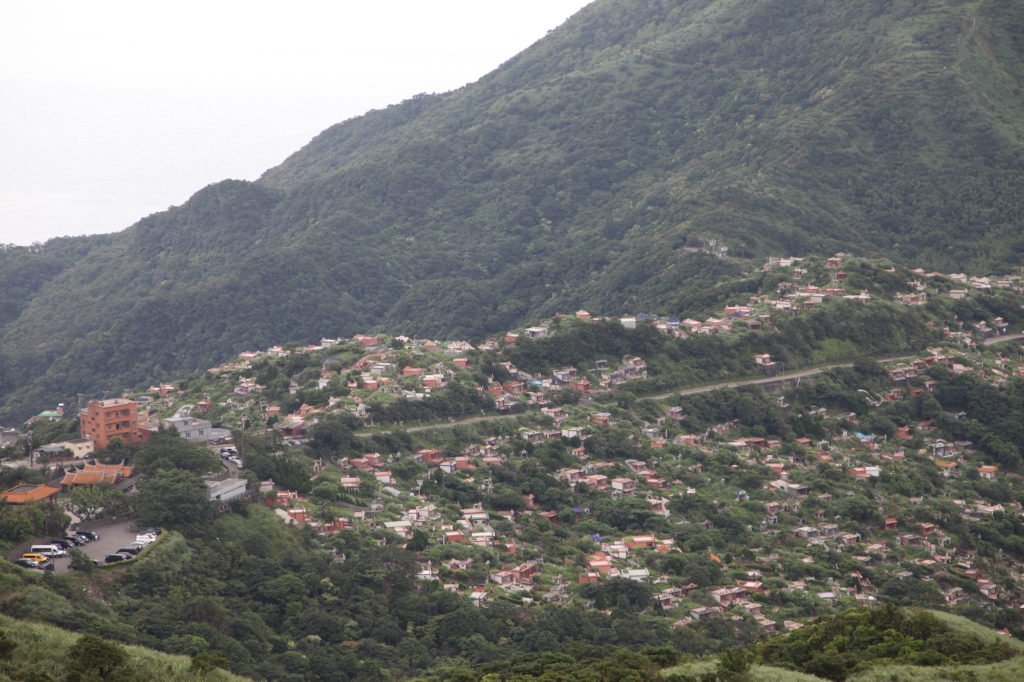
Graveyards in Taiwan like the one in this picture are jokingly referred to as a “nightclub” (夜總會)
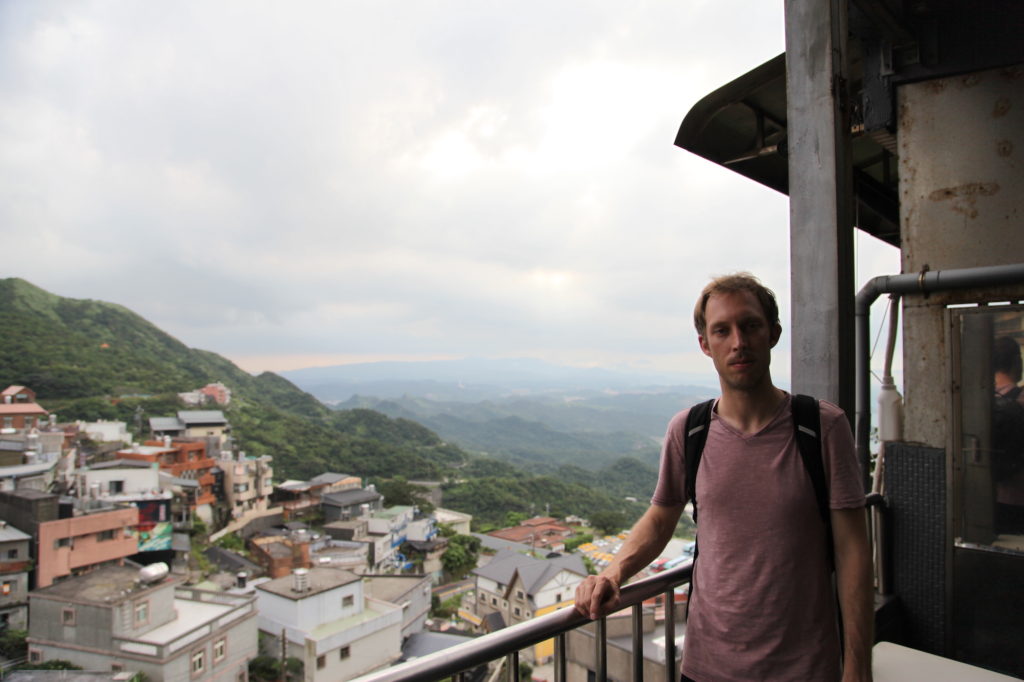
Jiufen
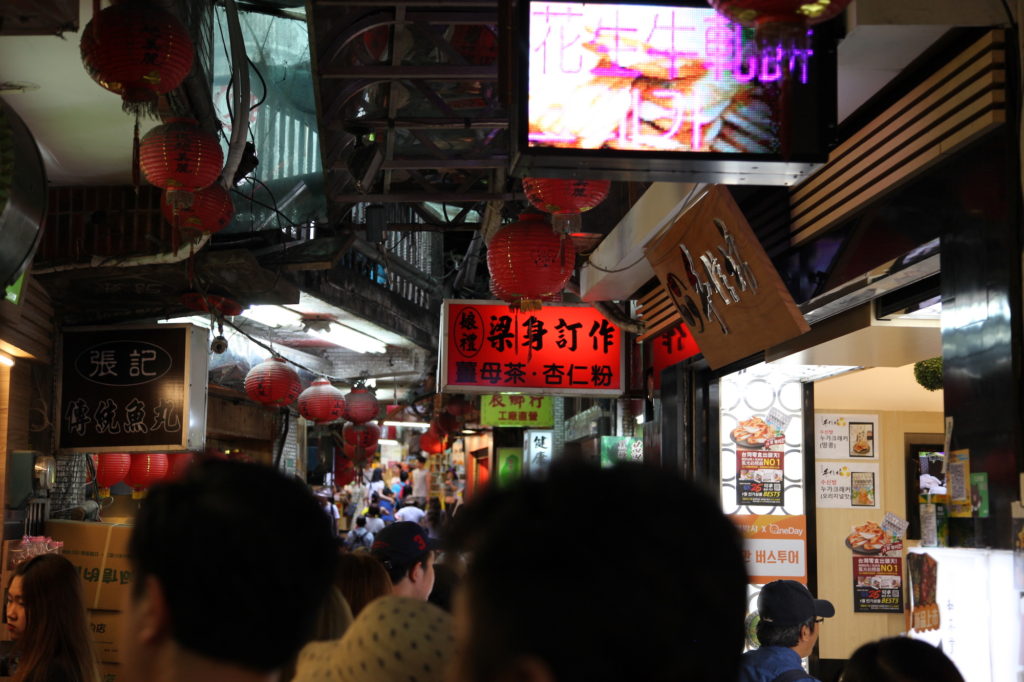
Jiufen Old Street
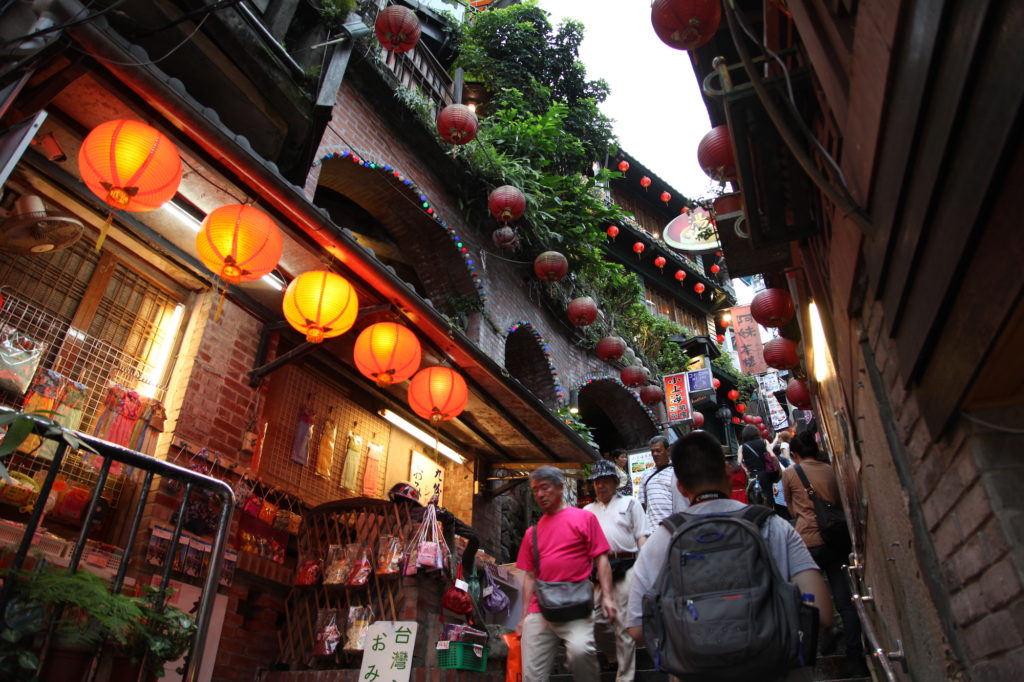
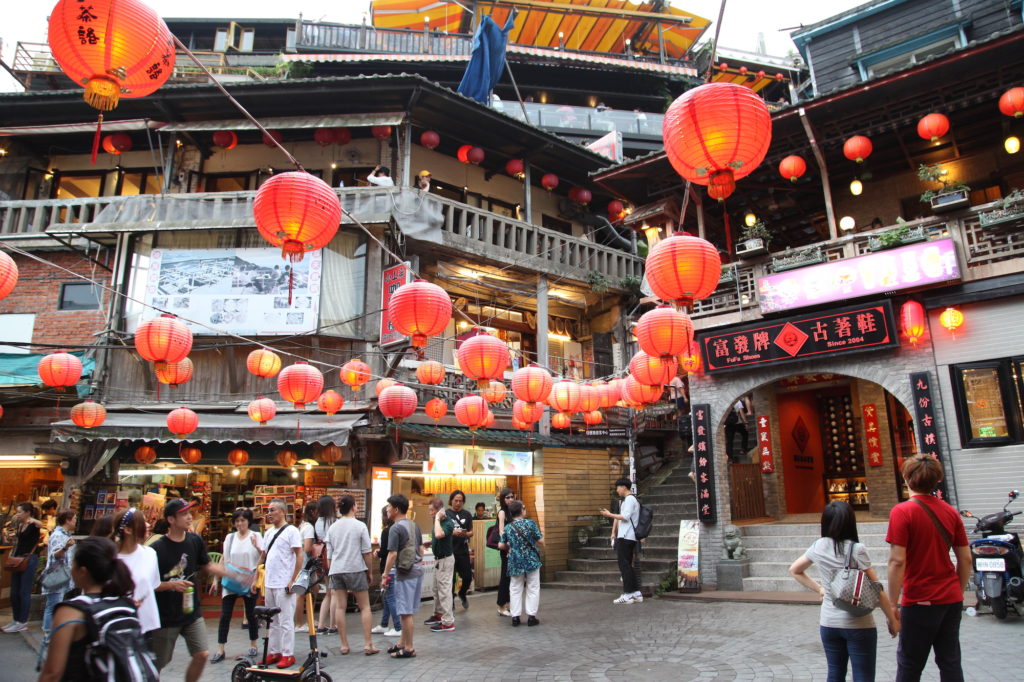
So-called Spirited Away teahouse

FamilyMart Convenience Store
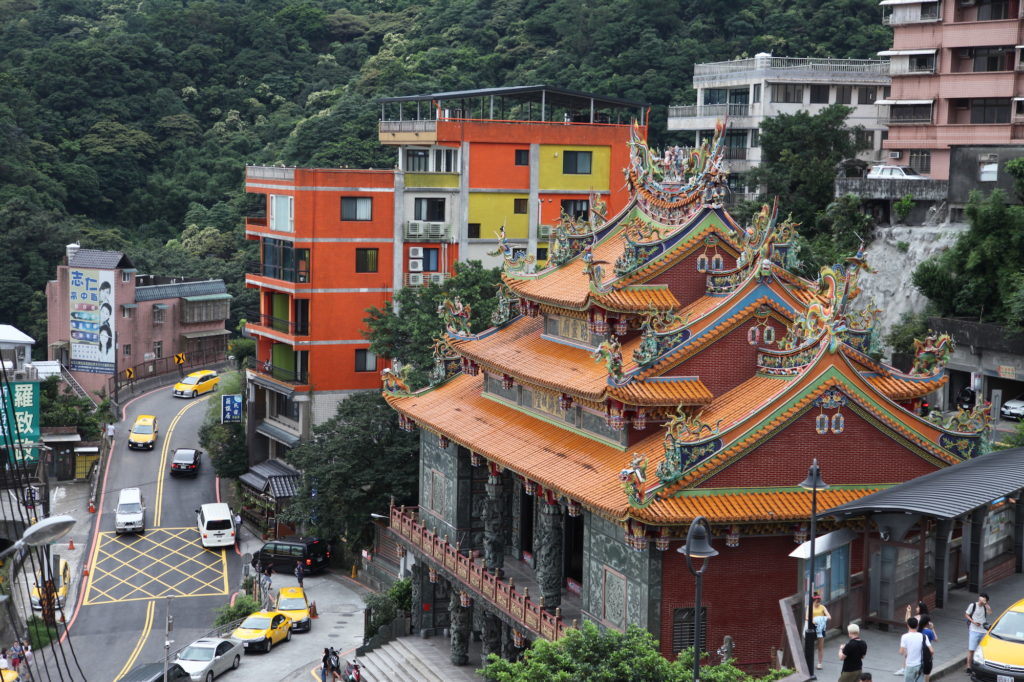
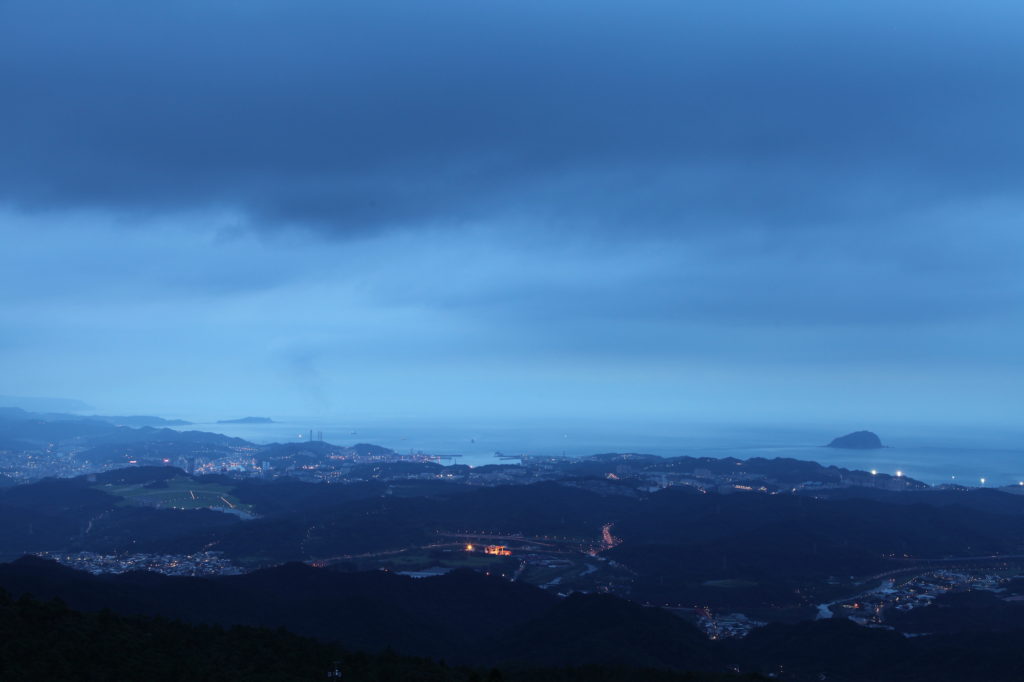
The view of Taiwan’s northern coast from one of the higher mountains in the area
Final Thoughts
The thing that struck me the most about this experience was the love and care that was shown in each interaction. From the reception desk volunteers’ listening to guests, to the shuttle bus volunteers greeting passengers, each job was done with attention and sincerity. I am grateful to Venerables Wu Dao and Zhuang Xing and everyone else who made it possible that I could stay on the mountain for this one week.
Lately I have often thought about why it has taken me four years to write this post; the thought to write it first occurred when I was staying at the temple, of course. At the time I was preoccupied with getting a job and finishing an online course so writing this post was put on the back burner. At the same time, it feels enough time has now past that I can do justice to the experience. It is said in the Tao Te Ching which is attributed to Lao-Tzu, “The journey of a thousand miles begins with one step” (千里之行,始於足下). This post feels like a single step in a journey of recounting my experiences in Taiwan.
Video
You can watch the video I put together during my weeklong stay at Shuangxi temple here:
Thanks to everyone who helped me produce this video!
How to Get to Shuangxi Retreat Center
If you’d like to visit Shuangxi and don’t have a car and can’t drive yourself, you have a few options. There are three main ways:
- Everyday at 8:30 am a shuttle bus from Taipei takes people to Shuangxi Temple.
- Take the train from Taipei to Shuangxi and then take the Shuangxi Temple shuttle bus from the train station to the temple.
- Take a cab or rent a car.
The journey lasts about one hour.
The meals, shuttle buses, and accommodation are all free of charge, but a donation is appreciated.
Shuangxi Temple Contact Information
Address: No. 1-1, Dapi, Shuangxi Dist.,
New Taipei City 227, Taiwan (R.O.C.)
Phone: (02) 2493-0076
Email: sx@hwadzan.com
Facebook: https://www.facebook.com/sxamtb
WeChat: hwamtb
Line: amtb24930076
Website: https://www.hwadzan.com/